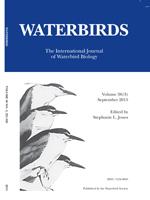The population of Common Terns (Sterna hirundo) in Barnegat Bay, New Jersey, USA, has recently experienced poor productivity with complete or near-complete breeding failure at multiple colonies, and the number of breeding pairs has declined. Adult Common Terns were captured and banded at Pettit Island from 2010 through 2014 and at four additional islands from 2011 through 2014. Although the number of breeding pairs on Pettit Island decreased and reproductive success was generally poor, this colony was more productive than the other colonies. Data from the other colonies were too sparse to treat each site separately, and the analysis is instead based on two “locations”: Pettit Island and all other sites. Apparent survival and movement probabilities were estimated using multistate capture-recapture modeling based on recaptures combined with resighting of color-banded Common Terns. The two best supported models included location, transience, and presence or absence of color bands as variables and produced very similar parameter estimates. Adult survival at Pettit Island was estimated at approximately 0.88, which is within the range of previous estimates for Common Terns. Survival estimates for the other sites had high uncertainty but appeared to be very low, at approximately 0.71. There was no evidence that apparent survival changed across time (2010–2012 compared to 2012–2014). Movement probabilities suggest a frequency of breeding dispersal within Barnegat Bay above 6%. Detection probabilities were much higher for color-marked birds than for those with metal bands only. Low apparent survival and decreases in the number of adults probably reflect permanent emigration out of the study area. The most likely cause of this decline in the Barnegat Bay population is frequent flooding due to sea level rise and severe storms.
How to translate text using browser tools
1 September 2015
Adult Survival and Breeding Dispersal of Common Terns (Sterna hirundo) in a Declining Population
Brian G. Palestis,
James E. Hines

Waterbirds
Vol. 38 • No. 3
September 2015
Vol. 38 • No. 3
September 2015
adult survival
Barnegat Bay
breeding dispersal
Capture-recapture models
climate change
Common Tern
population dynamics




